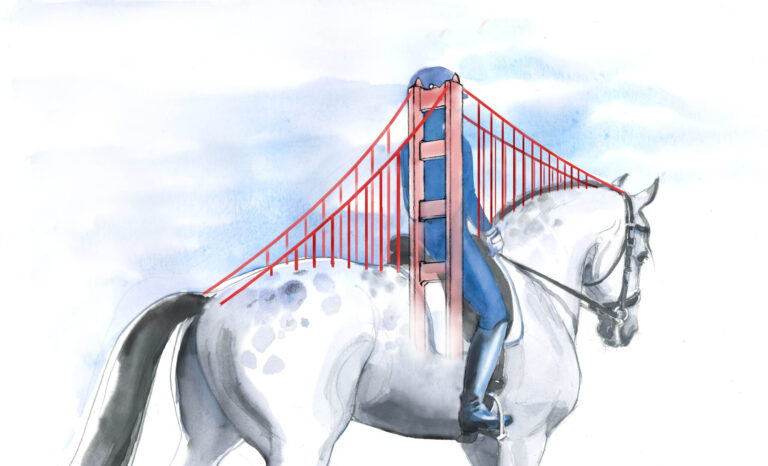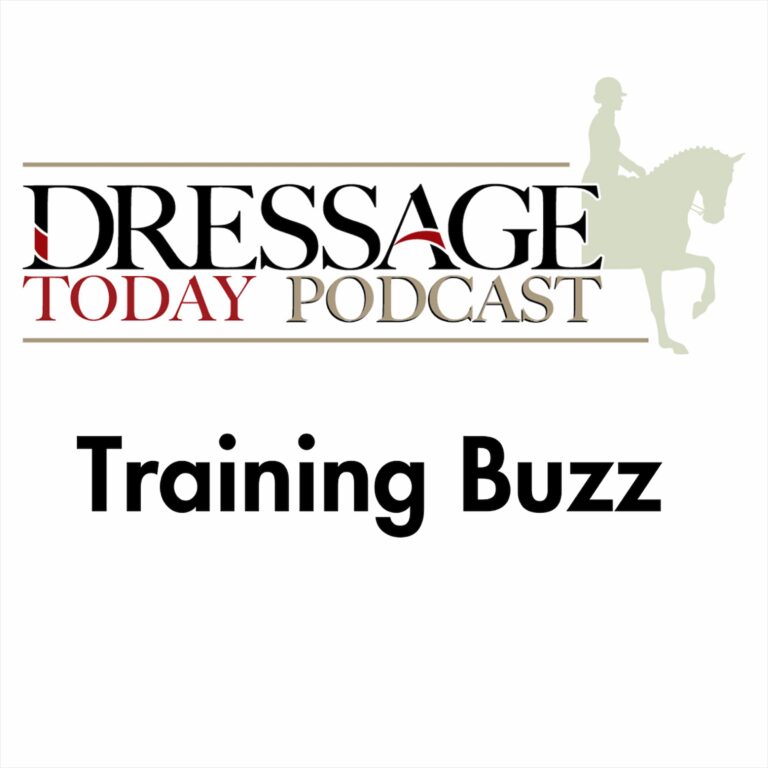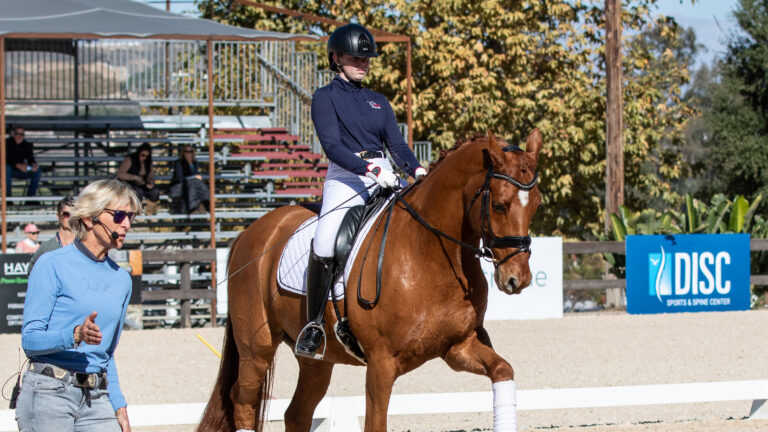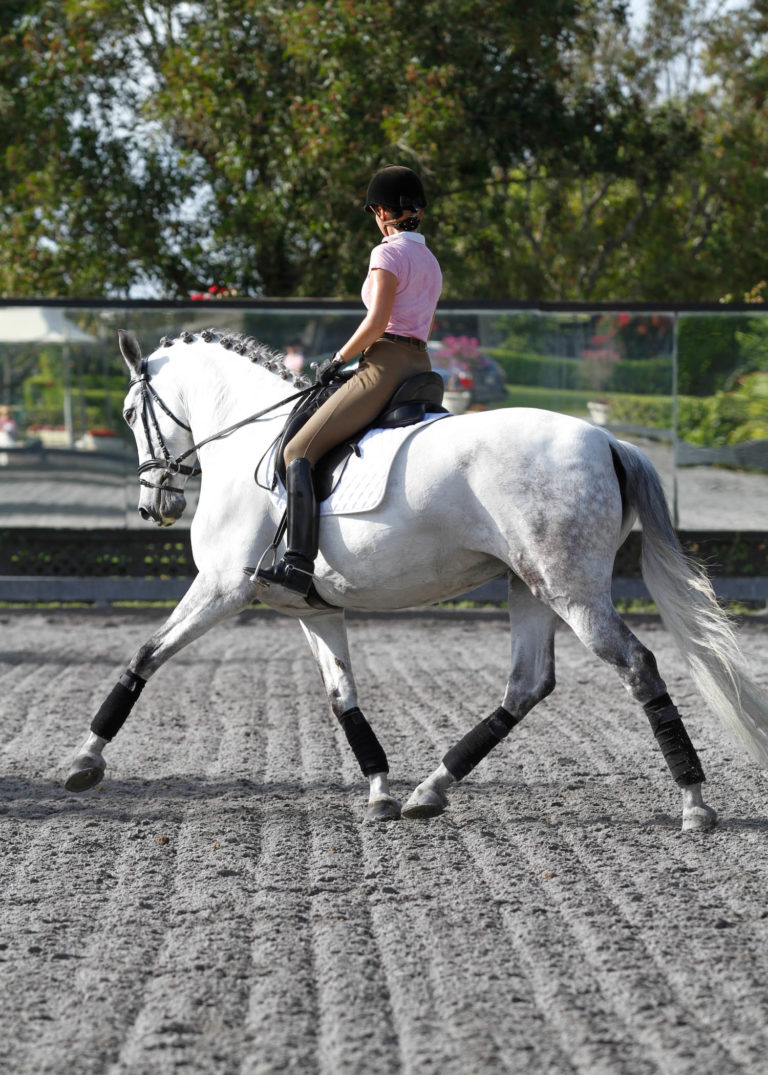Travers and renvers can be thought of as a mirror image of the same lateral movement. In both, the horse moves on four tracks (with the forelegs and hind legs crossing) at a 35-degree angle to the wall while still on a path of forward travel. Travers is haunches-in, so the haunches come inside the track that the horse’s shoulders travel on. Renvers is not simply haunches-out. The haunches in renvers are on the line of travel, and the shoulders are carried to the outside. Remember this when you perform them on the centerline.
As an Amazon Associate, Dressage Today may earn an affiliate commission when you buy through links on our site. Products links are selected by Dressage Today editors.
Both of these exercises help control the horse’s shoulder alignment and improve lateral suppleness, lightness of the forehand, hind-end engagement, thrust and suspension. All this is essential for developing collection and uphill balance and advancing up the levels. For example, travers is the foundation movement for developing the half pass and canter pirouettes. If the horse’s shoulders are out of alignment, he can’t elevate his forehand and achieve the uphill balance he needs for collected, medium and extended gaits.
Often when I judge at Second Level, instead of travers, I see the rider perform a leg yield facing the rail. Although the leg yield is of great benefit for schooling a horse to move sideways and forward at an angle as well as teaching him to cross his legs, it does not have the suppling benefits of travers because the horse now has to move in the direction of the bend for the first time instead of away from it. Here is how I ask my horses to do these two movements:
Travers
It’s important not to overdo it when introducing travers. Begin with a few steps and gradually increase the distance and how often the exercise is repeated. Change directions frequently as well as alternate travers with other exercises to give the horse’s muscles a break. Keeping him comfortable is important so he will enjoy his work.
The aids:
•I keep the horse’s shoulders on the track and bend his body around my inside leg, which is close to the girth.
•My outside leg is farther back, pushing the haunches off the track.
•I control his outside shoulder with my outside rein and keep the flexion with my inside rein.
•My weight is on my inside seat bone to allow the horse to bend throughout his body. To do this, I make sure my inside heel and knee are down slightly more than my outside ones. And, I give my outside active leg aids only with my lower leg.
•I keep my shoulders parallel to my horse’s shoulders, which are facing down the track. If I allow them to face toward the rail, my perceptive horse will do the same and lose the inside body bend. Only if his shoulders face down the track will he bend throughout his body and benefit fully from the suppling effect of performing travers.
I like to begin at the walk by riding a 12-meter circle to bend my horse. Keeping him about one meter off the track at the completion of the circle, I use my inside leg close to the girth to push his shoulders outward (toward the track) while keeping his haunches inside the track with my outside leg a bit farther behind the girth. If my horse is correctly bent—his shoulders, neck and head facing down the track—I can see straight down the track when I look between his ears. After a response of only a few steps of travers, I reward my horse by straightening him—pushing his haunches back onto the track with my inside leg.
Any time I introduce a new movement to a horse, I hold it only for a few strides before rewarding him by releasing my aids. A pat on the neck or a “good boy” is also a positive reinforcement.
When my horse responds to my aids for the travers in one direction, I introduce the travers in the other direction in the same manner.
Generally, travers is easier for the horse to perform on his “soft” side, usually the left or the direction he tends to bend on his own. However, many horses fall on their outside shoulder on their soft side rather than bending evenly throughout their bodies.
Bending toward the horse’s “hard” side will be uncomfortable at first. Only by stretching the muscles along his outside rib cage and back (as well as contracting the inside muscles) will he gradually become more laterally supple.
Troubleshooting: Generally, horses are a bit uncomfortable bending in the rib cage and will avoid it by tricking me into sitting incorrectly to the outside in travers so they don’t have to stretch their outside muscles. Some horses are even able to use their back muscles to shift my weight onto the outside of the bend. So, it’s an ongoing challenge to keep my weight correctly on my inside seat bone with my shoulders turned parallel to the short side of the arena.
Some horses have difficulty crossing their hind legs when learning travers. I have found that practicing turns-on-the-forehand and riding leg yields with the horse facing toward the rail helps him learn to cross his hind legs. Sometimes I practice turn-on-the-forehand on the ground (in-hand) because it allows me to watch the horse’s hind legs.
Here’s how I like to do it:
• I hold the reins just behind the horse’s jaw.
• My hand presses against his side, behind the girth. The horse should move his haunches away from the pressure of my hand. If there is no reaction, I reinforce my hand with a whip handle.
• Slightly moving him forward as he moves sideways also helps him to understand.
• As soon as he steps sideways, I praise him and release the pressure.
• Then I repeat the exercise on the opposite side.
Renvers
Renvers is a French word. It is often used instead of the term “haunches-out” because a horse carrying his haunches truly outward along the track would be challenged not to smash into the dressage arena fence. Because a horse can’t truly carry his haunches out when he is working next to the rail, renvers must be developed from either a shoulder-in (as it is asked for in the Second Level test) or from a half pass toward the rail.
The aids: They are the same as the aids for travers, except that renvers is developed from the shoulder-in. In shoulder-in, my shoulders are carried turned inward, parallel to my horse’s shoulders, and my weight is slightly more in my inside stirrup and seat bone. Usually my inside leg is close to the girth. My outside leg is carried farther back in case he wants to fall out toward the rail with his haunches.
Since my horse needs to change from an inside bend to an outside bend, I need to turn my shoulders so they face straight down the inside track in alignment with his head and shoulders in order to transition to renvers. I switch my weight more onto my outside seat bone (the one closest to the rail) while I hold my horse’s shoulders off the rail so they maintain the same or a slightly greater angle from the rail than they would have in a shoulder-in.
My outside leg needs to move more forward so it is on or just behind the girth to control the horse’s shoulders. I want them to stay inside the track. With my outside leg controlling the shoulders so they don’t fall back onto the track, I bring my inside leg back more to keep my horse’s haunches on the track.
Troubleshooting: By demanding that I change from an inside bend to an outside bend while maintaining a fairly consistent angle with the track, renvers teaches both my horse and me how to align as well as realign our bodies. Horses tend to fall on their outside shoulder when performing shoulder-in, causing them to lose the required even bend throughout their bodies as well as collection. By alternating shoulder-in with renvers whenever I feel my horse tends to fall on his outside shoulder, I can prevent this from happening and becoming a bad habit.
Just thinking of the aids for renvers is a useful exercise for straightening my horse when I feel him wanting to fall on his outside shoulder. Having the skill level and body control to perform renvers is essential for me to be able to keep my horse in alignment.
Renvers is in Second Level, Test 3, to make sure riders develop the skills necessary to prepare their horses for flying changes. Renvers sets the horse up for the change by realigning him and giving him the skills necessary to make a transition from one lead to another. It also prepares him for the higher levels when a change of direction in half pass is required.
Hilda Gurney is an FE! “I” dressage judge and two-time Olympian. She won a bronze medal in 1976 riding her Thoroughbred, Keen, and was inducted into the U.S. Dressage Federation Hall of Fame in 2007. A respected judge and clinician, she breeds horses, trains and teaches in Moorpark, California.









